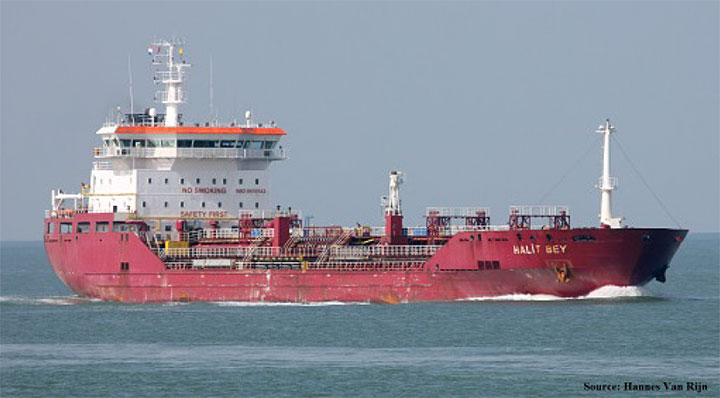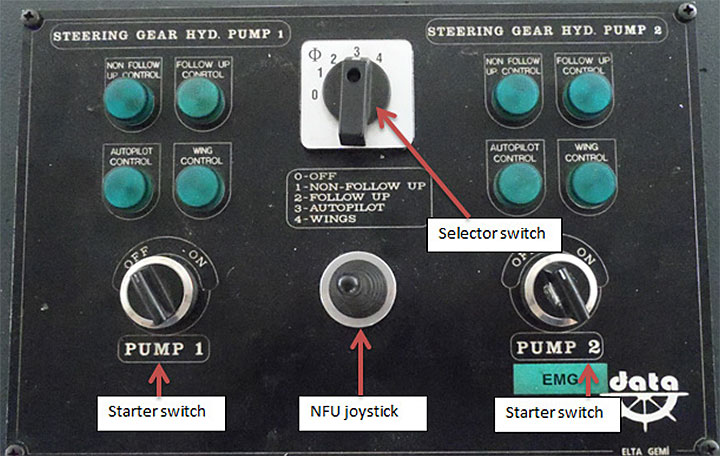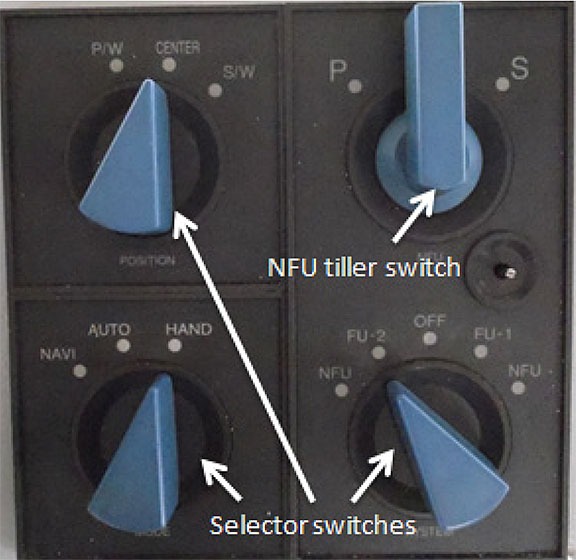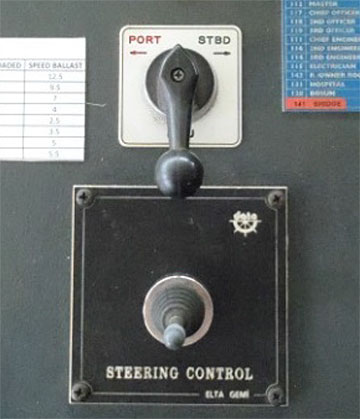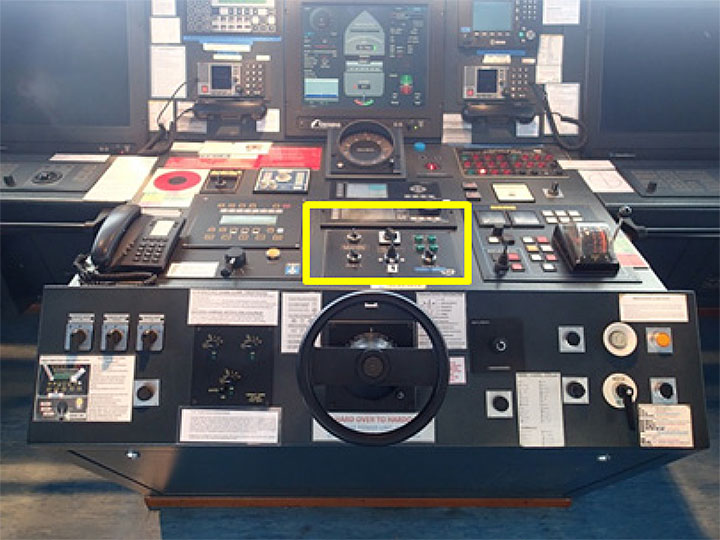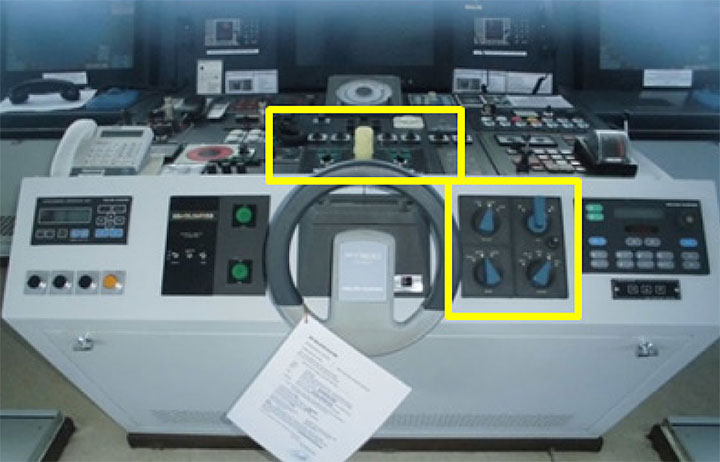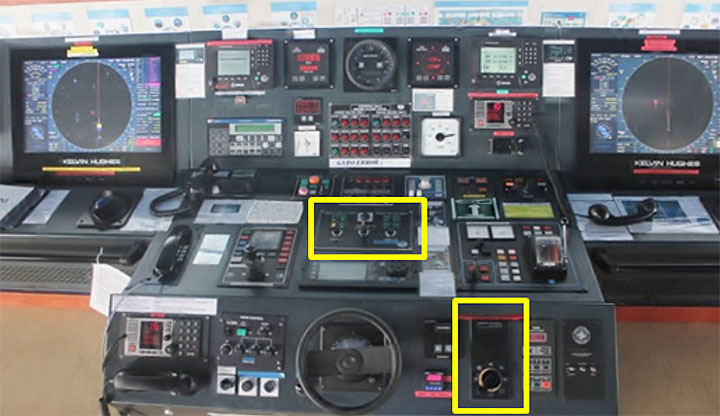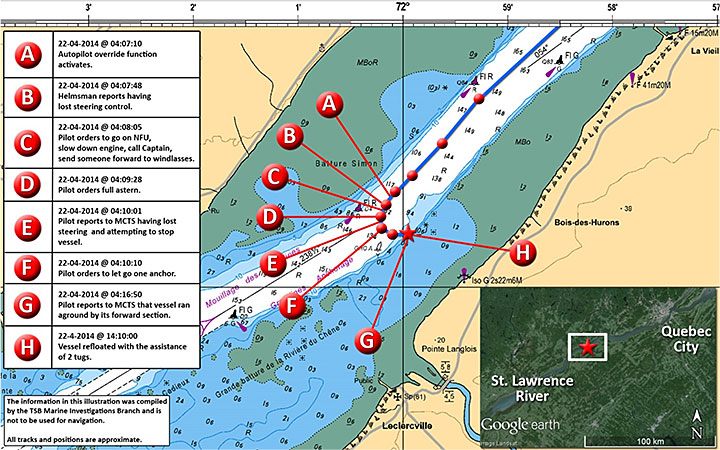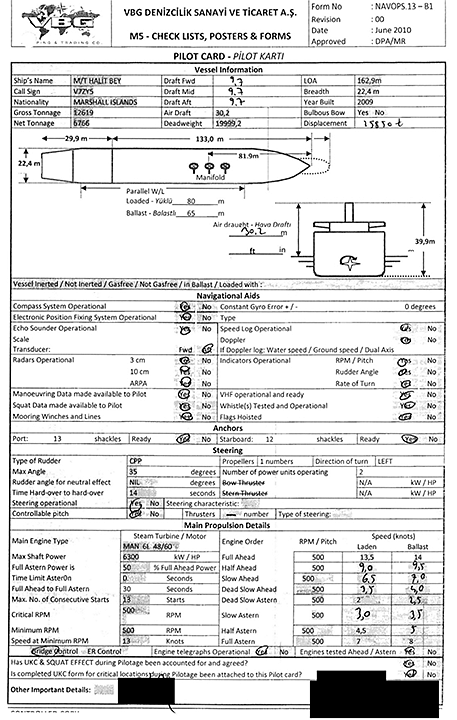Grounding
Chemical/products tanker Halit Bey
Grondines, Quebec
The Transportation Safety Board of Canada (TSB) investigated this occurrence for the purpose of advancing transportation safety. It is not the function of the Board to assign fault or determine civil or criminal liability. This report is not created for use in the context of legal, disciplinary or other proceedings. See Ownership and use of content. Masculine pronouns and position titles may be used to signify all genders to comply with the Canadian Transportation Accident Investigation and Safety Board Act (S.C. 1989, c. 3).
Summary
On 22 April 2014, the chemical/products tanker Halit Bey was proceeding upbound in the St. Lawrence River, under the conduct of a pilot, when steering control was lost. The vessel veered to port and exited the navigational channel, running aground on the south side of the river off Grondines, Quebec, at 0416 Eastern Daylight Time. The vessel was later refloated with the assistance of 2 tugs. No damage, pollution, or injuries were reported.
Factual information
Particulars of the vessel
| Name of vessel | Halit Bey |
|---|---|
| International Maritime Organization (IMO) number | 9410143 |
| Port of registry | Majuro |
| Flag | Marshall Islands |
| Type | Chemical/products tanker |
| Gross tonnage | 12 619 |
| Length overallFootnote 1 | 161.65 m |
| Draft at time of occurrence | Forward: 9.7 m Aft: 9.7 m |
| Built | 2009, Türker Gemi Yapim Sanayi Ve Ticaret A.Ş., Basiskele, Turkey |
| Propulsion | 1 medium-speed 4-stroke diesel engine (6300 kW at 500 rpm) driving a single controllable-pitch propeller |
| Cargo | Liquid fertilizer (11 780 metric tons of urea ammonium nitrate solution 32% and 6720 metric tons of ultrapure urea solution 32.5%) |
| Crew | 18 |
| Registered owner/manager | V.B.G. Denizcilik Sanayi Ticaret A.Ş., Turkey |
Description of the vessel
The Halit Bey is a double-hulled tanker designed for the carriage of liquid chemicals and oil products in bulk. The vessel is built of steel and has 20 cargo tanks and 2 slop tanks serviced by submerged centrifugal pumps. The machinery spaces and accommodations are located aft (Photo 1). The vessel also has an 800 kW bow thruster.
The bridge main control console is located on the centreline of the vessel and includes the steering wheel (commonly referred to as the helm), main engine controls, and bow thruster controls. Steering can be controlled via 2 steering gear control panels: 1 located on the bridge main console forward of the steering wheel (referred to hereafter as the centre control panel), and 1 to the right of the steering wheel (referred to hereafter as the right-hand control panel).
The bridge main console is also fitted with the following navigational equipment: an echo sounder, an electronic chart display and information system (ECDIS), 2 radars (fitted with automatic radar plotting aid capability), a global positioning system (GPS), an automatic identification system (AIS),Footnote 2 and 2 very high frequency (VHF) radiotelephones. The chart table and Global Marine Distress and Safety System (GMDSS) console are located aft of the main console, on the port and starboard sides of the navigation bridge respectively.
History of the voyage
On 09 April 2014, the Halit Bey departed Sluiskil, Netherlands, loaded with 18 500 metric tons of liquid fertilizer. The cargo was to be partially off-loaded in Trois-Rivières, Quebec, with the remaining cargo to be discharged in Valleyfield, Quebec (Appendix A). By 0015Footnote 3 on 22 April, the vessel had reached the pilot station in Québec, Quebec, where 2 pilots and an apprentice pilot boarded. The pilots requested to see the pilot card and subsequently advised the master that some of the information on the card was incorrect or incomplete.
After the pilots boarded, the vessel proceeded upbound in the St. Lawrence River and, at 0354, reduced speed to 4.8 knots in order to allow 2 other vessels to overtake it. The personnel on the bridge at this time consisted of a helmsman, an officer of the watch (OOW), the chief engineer, a deck cadet who was assisting the OOW, the 2 pilots, and the apprentice pilot. After the 2 vessels had passed, the pilot who was conning the Halit Bey ordered the engine telegraph to full ahead; it was set to 65 to 70% of the engine's maximum continuous rating, as per the chief engineer's standing orders. The helmsman was at the main console using the wheel to steer the vessel. The centre control panel just forward of the helmsman was set to autopilot and the right-hand control panel was set to follow-up mode.Footnote 4
At 0407, the vessel was nearing Grondines, Quebec (Appendix A) on a course over-the-ground of 221° with the rudder amidship. At this time, an alarm light on the steering control alarm panel lit up and an audible alarm sounded on the bridge. The chief engineer asked the OOW what the alarm was, and the OOW responded that it was the autopilot override alarm. Shortly after this exchange, the vessel started to veer to port, towards the south side of the river, and the helmsman reported that the helm was not responding. The pilot who was conning the vessel ordered the OOW to change the steering mode to non follow-up (NFU).Footnote 5 The pilot also ordered the OOW to slow down the engine, ask the master to come to the bridge, and send someone forward to prepare the anchors.
After the steering had been switched to NFU mode, the OOW, chief engineer, and helmsman each tried to use the NFU tiller switch on the right-hand control panel to actuate the rudder, but the rudder did not respond. They then tried toggling between steering modes using the switches on this same control panel, but the rudder still did not respond. At 0409, the pilot ordered the engine to half astern.
The master arrived on the bridge shortly after and also attempted to actuate the rudder using the NFU tiller switch. After this did not work, the master ordered the OOW and the bosun to the forward mooring station for an emergency anchorage. The pilot then ordered the engine to full astern. At this point, the vessel was approaching the outer limit of the navigational channel.
At 0410, the other pilot on board reported to Marine Communications and Traffic Services (MCTS) Québec that the Halit Bey had lost steering and that they were stopping the vessel. The speed over ground was 5.7 knots at this time. About 10 seconds later, the pilot who was conning the vessel ordered the anchor let go and, less than 2 minutes later, ordered the engine stopped. The master confirmed at 0412 that the starboard anchor had been dropped. The autopilot override alarm, which had remained on, was reset at 0413. Within the next 3 minutes, the Halit Bey exited the navigational channel and ran aground by its forward section.
At 0416, the pilot conning the vessel reported the grounding to MCTS, and the 2 pilots requested permission from the MCTS regulator to attempt refloating the Halit Bey. Permission was granted after consultation with Transport Canada Marine Safety and Security (TCMSS) and Canadian Coast Guard Environmental Response, but the pilots refrained from making an attempt due to concerns about damaging the vessel. The 2 pilots were relieved by 2 other pilots at 0900, while the apprentice pilot remained on board the vessel.
The Halit Bey remained hard aground for 10 hours. At 1330, an initial unsuccessful attempt to refloat the vessel was made using 2 tugs. This attempt was made under the conduct of the 2 new pilots and in the presence of a TCMSS inspector. At 1410, a second attempt was made, and the vessel was successfully refloated using the same 2 tugs and the vessel's own propulsion. Escorted by the tugs, the Halit Bey then proceeded, under its own power and with the steering in follow-up mode, to its assigned berth in Trois-Rivières, where it arrived at 1836. The vessel carried out its scheduled cargo discharge operations and left Trois-Rivières at 0115 on 24 April for Valleyfield. On 25 April, an underwater survey carried out by divers in Valleyfield concluded that the vessel had not sustained damage.
Environmental conditions
On the morning of 22 April, the weather was overcast with periods of rain and fair visibility. The wind was from the east at 4 to 5 knots, and the air temperature was 5°C. The predicted time of high tide for Grondines was at 0245, and the current was negligible. Sunrise was at 0451.
Vessel certification
The Halit Bey carried all required certificates for a vessel of its class and for the intended voyage. The vessel had a safety management certificate (SMC) issued by the American Bureau of Shipping (ABS). The SMC was issued on 04 May 2013 and was valid until 03 May 2018. The vessel also had a cargo ship safety construction certificate issued by ABS; this certificate was issued on 06 January 2013 and was valid until 20 May 2014.
Personnel certification
The crew members of the Halit Bey were all properly certified for their positions on board. The master held a Master's certificate of competency and had sailed as a master on various vessels belonging to the same company as the Halit Bey since 2009. He joined the Halit Bey on 27 December 2013. This was his first contract on board the vessel.
The chief engineer held a Chief Engineer's certificate of competency issued in 1996. He had sailed as a chief engineer on various vessels belonging to the same company as the Halit Bey since 2004. He joined the Halit Bey on 06 April 2014. This was his first contract on board the vessel.
The OOW held a Navigational Watchkeeping certificate of competency issued in 2006, and had since been sailing on different vessels in that position. He joined the Halit Bey on 06 April 2014.
The helmsman had been sailing since 2008 and was issued a Deck Able Seafarer certificate in 2009. He joined the company and the Halit Bey on 27 December 2013. This was his first contract on board the vessel.
The pilot conning the vessel at the time of the occurrence held a Master Mariner certificate and had obtained his Class A pilot licence in April 2004. The other pilot on board held a Master, Near Coastal certificate and had obtained his Class C1 pilot licence in April 2014. The apprentice pilot held a Master Mariner certificate and had obtained his Class D apprentice licence in April 2013.
Steering gear control system
The steering gear on a typical cargo vessel is controlled via a single steering gear control panel, located on the bridge main console, that gives the bridge crew the capability to toggle between different steering modes (follow-up, NFU, autopilot) and allows for control of port and starboard wing consoles, if the vessel is fitted with them.
At the time of the Halit Bey's construction, the shipbuilder installed 2 different steering gear control panels on the bridge main console: the centre control panel and the right-hand control panel (Photo 2). These 2 control panels had been manufactured by different companies.
On the centre control panel, in addition to the starter switches for the 2 steering gear pumps, there is a single selector switch to toggle between 5 different steering gear system modes: (0) OFF, (1) NON-FOLLOW UP, (2) FOLLOW UP, (3) AUTOPILOT, and (4) WINGS (Photo 3).
There is also a short black joystick that can be used to steer the vessel when it is operating in NFU mode; however, on the Halit Bey, it was not the practice to use this joystick. The joystick is positioned in the middle of the centre control panel and does not have an identification label, nor does it have a protective covering or any other locking feature to prevent accidental activation.
As indicated in Photo 4, the right-hand control panel comprises 3 selector switches and an NFU tiller switch. The top-left selector switch, labelled “POSITION,” allows the operator to toggle the steering controls between the port wing (P/W), centre, and starboard wing (S/W) consoles. The bottom-left selector switch, labelled “MODE,” allows the operator to control the steering by means of the ECDIS (NAVI),Footnote 6 the autopilot, or by hand.Footnote 7 the bottom-right selector switch, labelled “SYSTEM,” allows the operator to toggle between the follow-up (FU) and NFU modes, and to select which steering gear pump starter panelFootnote 8 is powering the steering control system. Whenever NFU mode is selected on either of the 2 power supplies, the NFU tiller switch in the top-right corner can be used to move the rudder to port (P) or starboard (S). The labels on this panel are illuminated and their brightness can be adjusted using a dimmer on the right side of the panel.
Steering modes
Follow-up mode
Follow-up mode is the most common way to steer a vessel when in restricted waters. In this mode, the steering wheel can be turned to port or starboard so as to request a rudder order between 0° and 35°. The system makes automatic adjustments to ensure that the rudder angle corresponds to the requested angle at all times.
On the Halit Bey, the bridge main console is fitted with a steering wheel that is used to steer when the vessel is in follow-up mode.
Non follow-up mode
NFU mode is a back-up method of steering that can be used in the event that the follow-up mode fails. In NFU mode, a tiller switch can be moved to the left or right, which moves the rudder towards port or starboard. In this mode, the helmsman must hold the tiller switch until the rudder reaches the required angle and then release the tiller switch to stop the rudder's movement. In the event that external forces or other conditions move the rudder from the desired angle, the helmsman must manually reposition the rudder using the tiller switch.
On the Halit Bey, there are 7 NFU steering controls; one is the short black joystick located on the centre control panel (Photo 3), one is the blue tiller switch located on the right-hand control panel (Photo 4), and one is an identical blue tiller switch located at the far right end of the bridge main console, between the voyage data recorder repeater display and the shipboard internal telephone. Each wing console also has 1 tiller joystick and 1 tiller switch. None of the NFU steering controls are fitted with protective safeguards.
Autopilot mode
Autopilot mode is generally used when a vessel is sailing in open waters. In this mode, the helmsman programs the desired course in the autopilot, which then automatically sends the appropriate electric signals to move the rudder towards the port or starboard sides, thereby keeping the vessel on course. Some autopilot systems are fitted with an autopilot override function that instantly disables the autopilot and defaults the steering mode to NFU, should the operator need to rapidly take back control of the steering.
The Halit Bey has an adaptive autopilot controllerFootnote 9 that is integrated into the vessel's steering control system. The autopilot and steering control system have different manufacturers. The Halit Bey's autopilot has an override function that is activated when the black NFU joystick on the centre control panel is moved.
Wings control mode
Operators on most modern cargo vessels have the capability to transfer steering control, in addition to the control of other systems, to consoles on the port or starboard bridge wings. The operator can then control the steering in NFU mode by the means of a single tiller switch on each bridge wing console.
The Halit Bey was fitted with port and starboard wing consoles that each had 2 NFU steering controls (Photo 5). The top tiller switch, labelled “NFU,” could be activated from the right-hand control panel, while the lower joystick, labelled “STEERING CONTROL,” could be activated from the centre control panel. There were no labels to indicate which steering control was connected to which control panel.
Steering gear alarm panel
The Halit Bey has a steering gear alarm panel located on the bridge main console forward and to the left of the steering wheel. The panel has 3 green lights to indicate the operating status of both steering gear pumps and the autopilot. It also has 16 red lights to indicate different types of steering gear system alarms, among which are alarms for autopilot failure, autopilot override activation, and autopilot override failure. The panel also includes push buttons to reset the autopilot override function, test the lights, and stop the audible alarm. The brightness of the panel lights is adjustable. All the components of the alarm panel are identified by non-illuminated labels.
Post-occurrence examination and testing of steering gear control system
Following the grounding of the Halit Bey, Transportation Safety Board of Canada (TSB) investigators boarded the vessel to test the steering gear control system. During the testing of the centre control panel to determine which steering controls functioned in which mode (Appendix B), TSB investigators observed the following:
- When the selector switch on the centre control panel is set to follow-up mode (position 2), all steering controls are disabled.
- When the selector switch on the centre control panel is set to autopilot (position 3), the autopilot does not engage. Instead, this transfers steering control selection to the right-hand control panel. It was the practice on board the Halit Bey for the centre control panel to always remain set to autopilot (position 3), and for the bridge officers to use only the right-hand control panel to select the steering mode.
- Although position 3 on the centre control panel does not engage the autopilot, the associated autopilot override can still be activated by touching the black NFU joystick located on the centre control panel. Only a light touch of the joystick is necessary to activate the autopilot override. The autopilot override can be activated not only when the vessel is operating in autopilot, but also when it is operating in follow-up or NFU mode.
- When the autopilot override activates, all means of steering on the bridge are disabled, with the exception of the black NFU joystick on the centre control panel. The steering automatically defaults to NFU mode
- To reactivate the other means of steering after the autopilot override has been activated, an operator must press the override reset button on the steering gear alarm panel, which resets the steering control system to its initial condition.
Steering gear trials determined that the vessel met the Safety of Life at Sea (SOLAS) Convention requirements with respect to the functionality of the main steering gear.Footnote 10 It took an average of 25 seconds to move the rudder from 35º on one side to 30º on the other side with 1 steering gear pump running, and 14 seconds with 2 steering gear pumps running. During the trials, the steering gear reached a maximum angle of 35° on both the port and starboard sides.
Comparison of steering gear control systems
Following the occurrence, TSB investigators boarded a chemical/products tanker similar to the Halit Bey in order to compare steering gear control systems. The comparison vessel, the Manas (IMO 9447055), is fitted with a steering control and alarm system supplied by the same manufacturer as the one installed on the Halit Bey. The general bridge arrangement and equipment on board the Manas is similar to the Halit Bey, except that there is a single steering control selector switch panel located in front of the steering wheel (Photo 6), and the port and starboard wing consoles are fitted with single NFU control sticks.
Steering tests were carried out on the Manas, during which the investigators tested the functionality of all steering controls in each steering mode. The results were as follows:
Off: all steering modes are disabled.
NFU: the vessel can be steered using the black stick located on the steering control panel.
Follow-up: the vessel can be steered using the steering wheel.
Autopilot: the vessel is being steered by the autopilot. Touching the stick located on the steering control panel activates the autopilot override alarm and deactivates the autopilot; the steering controls automatically switch to NFU mode and the vessel can be steered by using the stick.
Wings: the vessel can be steered in NFU mode using the port and starboard console sticks.
Sister vessels
The Halit Bey has 2 sister vessels: the Nilufer Sultan (IMO 9410131), built in 2008, and the Mehmet A (IMO 9418822), built in 2011. The 2 vessels are fitted with steering gear control arrangements similar to the Halit Bey, combining 2 separate steering control panels, one installed in front of the steering wheel and the other located to the right of the steering wheel (Photo 7 and Photo 8).
Post-occurrence inspection by manufacturer's authorized technician
On the evening of 22 April, following the occurrence, a technician boarded the Halit Bey at the request of the vessel's owners. The technician carried out an inspection of the steering gear control system and tested the functionality of all steering modes. The technician's service report mentions that the steering had been tested alongside the dock, and that it “did work normally.” The report also noted that the technician “could not duplicate [the] steering failure condition but [it] must be remembered that when [the] centre joystick to override is used, all other controls are non-operational” and that the operator must “press [the] override reset button to get control back.” During the tests with the selector switch of the centre control panel set to position 2 (follow-up), the technician noted that the “joystick from the centre, port wing, starboard wing [were] not active; steering wheel [was] not active.”
Steering control documentation
For vessels operating under the International Management Code for the Safe Operation of Ships and for Pollution Prevention (ISM Code), the company has a responsibility to establish procedures for the preparation of plans and instructions for key shipboard operations,Footnote 11 including those related to the steering gear of a vessel.
The Halit Bey carried a shipboard manual that contained technical specifications of the steering components, technical and electrical drawings, and certificates of type approval for both the autopilot and the steering console. There were posters displayed on the bridge that explained the procedure to toggle between steering modes using the right-hand control panel, but there was no information regarding the centre control panel and its various functions or how to use the centre control panel in conjunction with the right-hand control panel. There was no mention of the NFU joystick and the autopilot override function. The vessel did not carry an operational manual for the steering gear control system.
Familiarization with bridge equipment
Under the ISM Code, the company is responsible for establishing procedures to ensure that new personnel and personnel transferred to new assignments related to safety and protection of the environment are properly familiarized with their duties.Footnote 12
The managing company for the Halit Bey had established checklists to address different aspects of safety maintenance, verification, and crew training. One of the checklists, entitled “Bridge Check List 1 - Familiarization with Bridge Equipment,” lists the navigation equipment and controls to be studied and understood by the bridge crew member upon joining the vessel. Among other things, this checklist stipulates the various methods of steering control with which crew members must be familiarized: manual steering, autopilot, emergency change-over, and testing arrangements. When all of the listed items are checked off to indicate the completion of familiarization, the form is signed by the crew member, the officer in charge of familiarization, the head of the department, and the master.
This checklist had been completed and signed for both the OOW and the helmsman.
Steering drills and testing
The SOLAS Convention includes a description of the periodic tests and drills that must be performed on a vessel's steering gear.Footnote 13 These tests and drills were replicated on the steering gear drill record that formed part of the Halit Bey's safety management system documentation.
On the Halit Bey, the emergency steering gear drills followed a single scenario: the crew simulated a total failure of the navigation bridge steering control system and the engine room personnel operated the steering gear locally while maintaining two-way communications with the bridge team. The last drill had taken place on 14 April 2014, 8 days before the occurrence.
The vessel's emergency steering gear test log states that all of the tests and verifications are to be performed by engine room personnel. The test log was filled out on a weekly basis and signed off by the first engineer, the electrician, the chief officer, and the chief engineer. The tests and verifications were all done from the steering gear compartment. The last periodic tests and verifications were also done on 14 April, 8 days before the occurrence.
Regulatory oversight
Port State Control inspection
Port State Control (PSC) is a vessel inspection program whereby foreign vessels entering the waters of a sovereign state are boarded and inspected to ensure compliance with various major international maritime conventions.Footnote 14 In Canada, PSC inspections are carried out by TCMSS inspectors.
The Halit Bey underwent a PSC inspection the day following the vessel's arrival in Trois-Rivières. The report issued by the 3 attending PSC officers states that the vessel's steering gear room had been visited and that the local emergency steering had been tested. During the inspection, the various steering gear control modes on the bridge were also tested. The PSC officers observed that the vessel's steering system was fitted with 2 separate steering gear control panels and that some functional incompatibility existed between the various steering modes.
The PSC inspection report identifies one deficiency, as follows: “Vessel grounded 2014-04-22 crew not aware of steering procedures on the bridge (ISM related).” The master was given 3 months to rectify this non-conformity and to arrange for an internal safety audit to take place on board the vessel.
Classification society survey
According to the International Association of Classification Societies (IACS), the objective of vessel classification is to verify the structural strength and integrity of essential parts of the vessel's hull and its appendages, as well as the reliability and function of various essential systems, such as the propulsion and steering systems.Footnote 15
For the Halit Bey, the classification society ABS is the recognized organization responsible for issuing all statutory certificates on behalf of the flag state administration, including the cargo ship safety construction certificate.
On the evening following the occurrence and during the next day, an ABS surveyor boarded the Halit Bey to conduct an internal structural assessment of the vessel. While on board, the surveyor carried out trials of the steering gear system. The surveyor also consulted the steering system's authorized technician's service report, which mentioned the use of the centre joystick deactivating the controls from the right-hand control panel. The surveyor's report made no conclusions about the loss of steering and the cause of the grounding, as this was out of the scope of the surveyor's visit.
Bridge design and arrangement of equipment
ABS publishes guidance notes on the ergonomic design of navigation bridges that are intended to inform vessel designers of principles and data relevant to the design of navigation bridges. Within these guidance notes, ABS specifies that “to the extent possible, equipment should safeguard against human error” and that “control locations and physical arrangements should be designed to prevent the accidental manipulation of those controls that could result in changes to the status of the system.”Footnote 16 The guidance notes suggest that “one way to accomplish this is through physical protection and/or placement on the equipment.”Footnote 17
The guidance notes also mention the readability of instruments, indicating that “instruments should be designed to permit easy and correct reading by day and night” and state that “the presentation of alarms should be clear, distinctive, unambiguous, and consistent.”Footnote 18
Pilot card
A pilot card is intended to provide information to the pilot upon boarding the vessel. It is completed by the master and contains information on the current condition of the vessel with regards to its loading, propulsion, and manoeuvring equipment, as well as other relevant equipment.
On the Halit Bey, the pilot card contained some information that was incorrect: the type of rudder was described as “CPP,”Footnote 19 the vessel's minimum speed was stated to be 13 knots, the direction of propeller rotation was recorded as being opposite to that depicted on the sketch, and the main engine critical speed was stated to be 500 revolutions per minute, which was the same as the nominal speed. In addition, the line to indicate if the vessel had a bulbous bow had not been filled out (Appendix C).
Voyage data recorder
The purpose of a voyage data recorder (VDR) is to record and safeguard critical information and parameters relating to the last hours of a voyage in order to help relevant authorities with investigations into the causes and contributing factors of an occurrence.
The VDR on board the Halit Bey was designed to record the following parameters: AIS data from surrounding vessels, radar images, bridge audio,Footnote 20 VHF radiotelephone conversations, gyrocompass heading, rate of turn, rudder angle, geographical position (latitude and longitude), course and speed over ground, relative wind speed and direction, water depth, propeller pitch, and engine speed. The VDR had a certificate of type approval and had undergone a mandatory annual performance test on 28 March 2014. The service report stipulated that all functions were checked and had passed.
Following the occurrence, TSB investigators extracted all of the data recorded by the Halit Bey's VDR, but found that the VDR had only recorded radar images and bridge audio. It could not be determined why the VDR had not recorded the other parameters.
Analysis
Events leading to the grounding
The Halit Bey was proceeding in follow-up mode in restricted waters when steering control was lost, likely when the unprotected non follow-up (NFU) joystick located on the centre steering control panel was inadvertently moved. The design of the Halit Bey's steering gear system was such that touching the NFU joystick activated the autopilot override alarm, even though the vessel was not in autopilot mode. As such, all steering controls on the bridge were disabled, except for the NFU joystick. Without steering control, the vessel veered towards the shore.
The bridge crew, having never encountered a situation of this kind before and not knowing why the autopilot alarm had sounded, were unaware of the available options to regain steering control (the NFU joystick could still be used to steer the vessel or the override reset button on the steering gear alarm panel could be pressed to reset the steering control system). In the limited time prior to the grounding, the crew attempted an emergency anchorage; however, the vessel exited the navigational channel and ran aground.
Bridge design and arrangement of equipment
It is essential that critical bridge systems, such as steering gear control systems, be designed to be straightforward and intuitive for the operator. Good system design will also take into account concepts such as error tolerance, whereby a system is designed to minimize potential errors (by including locking features or protective coverings,Footnote 21 for example) or limit the consequences of accidental activation by leaving the vessel in a safe condition should this occur.
On the Halit Bey, the steering gear control system incorporated 2 different steering gear control panels from 2 different manufacturers and, as such, had an incompatibility between the panels with respect to the autopilot override. The centre control panel was essentially redundant, so the practice on board was to leave it on position 3 (autopilot), which transferred steering control to the right-hand panel. However, unbeknownst to the crew, the autopilot override and associated alarm could still be activated by the NFU joystick on the centre control panel, even when the vessel was not in autopilot mode. Activation of the autopilot override had the effect of disabling all steering controls on the bridge, with the exception of the NFU joystick itself.
In addition, the steering gear control system did not incorporate protective coverings or locking features on the steering controls, nor was there any information provided to the operator during an autopilot override alarm to indicate which steering controls remained functional or how steering control could be regained. The redundant centre control panel was still marked with its original labels, introducing the possibility of confusion for operators unfamiliar with the particularities of the system. Finally, the design of the steering control system meant that the wing consoles both had 2 NFU steering controls, each one wired to a different steering control panel, which unnecessarily complicated the wings mode and had the potential to confuse its operator, given that the steering controls did not have labels to indicate which steering control was connected to which control panel.
In this occurrence, the autopilot override alarm activated while the vessel was operating in follow-up mode, providing a conflicting message to the crew members that delayed their taking action because it was not clear to them how steering control could be regained in this unusual situation. If critical bridge systems, such as steering gear control systems, are not designed and arranged to be straightforward and intuitive with safeguards to minimize human error, there is a risk that an operator will not be able to respond quickly and effectively in the event of an emergency.
Familiarization with safety critical equipment
In order to effectively use shipboard equipment, crews must know how it operates during routine and emergency situations, as well as how to regain control should it be lost. That knowledge may come from technical manuals, familiarization, drills and/or posted procedures.
In this occurrence, given the characteristics of the vessel's steering control system, it was especially important that crew members be familiarized with all of the various steering modes and controls, as well as what to do in case of an autopilot override alarm. However, the Halit Bey's on-board familiarization did not specifically require crew members to be familiarized with methods to regain steering control following an autopilot override alarm, and the 2 possible methods were not mentioned on the on-board familiarization checklist. There was no specific information about how to regain steering control posted near the steering stand, and the vessel did not carry an operational manual for the steering control system.
The vessel's emergency steering drills, while complying with Safety of Life at Sea (SOLAS) requirements, were based on a single scenario that did not include testing the steering controls and use of NFU mode, switching between steering modes, or recovering the helm after the activation of the autopilot override. As such, there were limited opportunities for the bridge crew to become familiar with the back-up steering arrangements and the characteristics of the Halit Bey's steering system. The bridge officers, none of whom had more than 4 months' experience on the vessel, were therefore not familiar with all of the various steering arrangements, nor had they previously encountered a situation where the autopilot override had activated while the vessel was not on autopilot. As such, they were unable to respond effectively and regain steering control.
If crew members are not familiarized with all aspects of the operation of safety critical equipment, such as a vessel's steering control system, there is a risk that they will not have the knowledge required to operate the system proficiently or regain control in the event that it is lost.
Voyage data recorder
The purpose of a voyage data recorder (VDR) is to create and maintain a secure, retrievable record of information indicating the position, movement, physical status, and control of a vessel for the period covering the most recent hours of operation. Objective data are invaluable to investigators when seeking to understand a sequence of events and identify operational problems and human factors.
In this occurrence, the Halit Bey's VDR recorded only radar images and bridge audio, limiting the data available for this investigation.
If bridge and data recordings are not available to an investigation, this may preclude the identification and communication of safety deficiencies in order to advance transportation safety.
Findings
Findings as to causes and contributing factors
- Steering control from the steering wheel was disabled likely when the unprotected non follow-up joystick was inadvertently moved, which activated the autopilot override and alarm.
- An incompatibility between the steering gear control panels meant that even when the vessel was not operating in autopilot mode, touching the non follow-up (NFU) joystick still activated the autopilot override and associated alarm, which disabled all of the steering controls except for the NFU joystick itself.
- The bridge crew was not adequately familiarized with the characteristics of the Halit Bey's steering control system and did not know how to regain steering control after the autopilot override alarm activated.
- After steering control was lost, the vessel veered to port, towards the shore.
- The crew's attempt to reduce speed and anchor the vessel were unsuccessful, in the limited time available, to prevent the vessel from exiting the navigational channel and running aground.
Findings as to risk
- If critical bridge systems, such as steering gear control systems, are not designed and arranged to be straightforward and intuitive with safeguards to minimize human error, there is a risk that an operator will not be able to respond quickly and effectively in the event of an emergency.
- If crew members are not familiarized with all aspects of the operation of safety critical equipment, such as a vessel's steering control system, there is a risk that they will not have the knowledge required to operate the system proficiently or regain control in the event that it is lost.
- If bridge and data recordings are not available to an investigation, this may preclude the identification and communication of safety deficiencies in order to advance transportation safety.
Other findings
- The pilot card contained some information that was incorrect or incomplete.
- The labels for the alarms on the steering gear bridge alarm panel were not illuminated and were difficult to read at night; the bridge crew had to use an independent lighting device to read the labels in order to identify and acknowledge the alarm.
- Two sister vessels, built by the same shipyard, are fitted with steering gear control arrangements similar to the Halit Bey, combining 2 separate steering gear control panels.
- During post-occurrence testing of the vessel's steering control system, Port State Control officers and the surveyor from the vessel's recognized organization became aware that the vessel's steering system was fitted with 2 incompatible steering gear control panels, but did not require action from the owners to remedy this.
Safety action
Safety action taken
Transportation Safety Board of Canada
On 29 May 2014, the Transportation Safety Board of Canada (TSB) forwarded Marine Safety Advisory (MSA) letter 05/14 to the vessel owners to identify the issues with the configuration of the steering gear controls and the familiarization of the navigation crew members with the steering gear system on board the Halit Bey. A copy of the letter was also sent to Transport Canada, the relevant flag state authorities, the classification societies for the 2 sister vessels, the owners of the sister vessel Mehmet A, and the International Association of Classification Societies.
VBG Shipping and Trading Company
Following the grounding, complete emergency change-over procedures were posted on the bridge of the Halit Bey and the Nilufer Sultan, taking into account the particularity of the steering control that could be disabled if the autopilot override mode is activated. The company also issued a fleet-wide navigation safety circular with a photograph of the selector switch, located on the centre steering control panel, to share the lessons learned from this occurrence. Crew members taking part in the navigational watch were trained on the Halit Bey's specific steering arrangements, and the familiarization procedure and checklist for navigational crew members who are new to the vessel were amended to specifically address and improve situational awareness regarding the non follow-up joystick. Additionally, a protective guard was installed over the joystick on the centre steering control panel on each of the 2 vessels.
This report concludes the Transportation Safety Board's investigation into this occurrence. The Board authorized the release of this report on . It was officially released on .
Appendices
Appendix A - Area of the occurrence
Appendix B – Results of post-occurrence testing of steering gear control system
| Steering controls | Steering mode | ||||
|---|---|---|---|---|---|
| 0 - Off | 1 - NFU | 2 - Follow-up | 3 - Autopilot | 4 - Wings | |
| Steering wheel | – | – | – | √ if right-hand panel is set to centre + hand + FU-1 or FU-2 | – |
| Centre control panel NFU joystick (in front of steering wheel) | – | √ | – | √* *touching the joystick disables all other steering controls |
– |
| Right-hand control panel NFU tiller switch (at right of steering wheel) |
– | – | – | √ if right-hand panel is set to centre + hand + NFU | – |
| Bridge main console NFU tiller switch (at far right end of console) | – | – | – | √ if right-hand panel is set to centre + hand + NFU | – |
| Port wing console NFU tiller switch | – | – | – | √ if right-hand panel is set to P/W + hand + NFU | – |
| Port wing console steering joystick | – | – | – | - | √ |
| Starboard wing console NFU tiller switch | – | – | – | √ if right-hand panel is set to S/W + hand + NFU | – |
| Starboard wing console steering joystick | – | – | – | – | √ |
Note: A check mark (√) indicates when a steering control functioned in a particular mode and a dash (–) indicates when it did not.
Appendix C - Pilot card
Note: To protect individual privacy, the Transportation Safety Board (TSB) has blacked out names that were written on this document.
